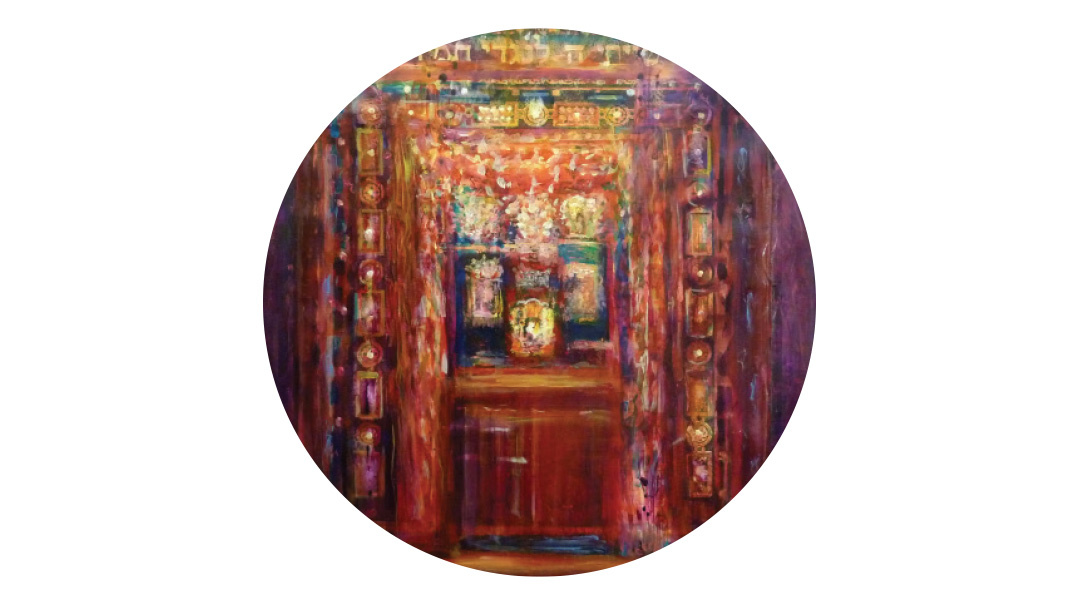Say Yes to Kindness


With her Rus brought the key to humanity’s redemption
D
epending on who you are or what your cultural milieu is, Rus can be seen either as a heroine or an anti-heroine. On the one hand, she’s the main protagonist of the megillah; on the other, she is so self-effacing as to almost disappear off the pages — twice, the word eilai (“to me”), referring to Rus, is pronounced but erased from the text (what’s called a kri u’kesiv). On the one hand, the megillah is named after Rus, she’s called “Mother of Royalty”; on the other, after the whole saga is over, the neighbors crowd around and announce that a baby was born to Naomi!
Self-effacement doesn’t get very good press nowadays, when women are bombarded with messages to make sure their own needs are met, to know when to say no, and to be in touch with themselves. Yet even as we roll our eyes at this “me generation” (hi, Kiki!), there is something to be said for being in tune with yourself, knowing your needs, and communicating your desires.
So was Rus’s self-effacement good or bad?
Rus lets Naomi take center stage and marries Boaz because it was the right thing to do. This seems to make Rus a bubby’s heroine, even as the younger generation might squirm in discomfort.
Yet before we succumb to the knee-jerk tendency to paint all of modern society as negative, perhaps the awareness that Hashem is running the world compels us to mine social trends for the grain of truth they hold. Perhaps this me generation has something important to say.
Nebulous Roots
Rus’s murky Moabite lineage and her meteoric rise to greatness as the progenitor of King David — and through him, Mashiach — pack a very powerful punch in Jewish thought. The fact that Mashiach could descend from someone who came from such a lowly place — Rus’s forefather Lot ran away from Avraham to Sedom, of all awful places — provides an incredible message of hope, and of the power of the individual to soar beyond any limitations.
Interestingly, the Midrash does not try to smooth over these unprepossessing ancestors. In fact, it articulates our shock that such lowliness could possibly rise to such greatness: “I have found My servant, David!” G-d proclaims. “And where have I found him? In Sedom!” (Midrash Rabbah, Bereishis, 50:10)
Rus was a direct descendant of enigmatic Lot, who started off on such a high — the only one of Avraham’s relatives who managed to extricate himself from Charan and follow Avraham to the land of Canaan. The same Lot who, at the last minute, gave all this up and chose to settle in Sedom, a rabidly xenophobic city where do-gooders were tortured and all resources were invested in upholding an anti-chesed community.
It’s hard to fathom. How could Lot, who had imbibed Avraham’s greatness, have chosen to establish himself in a place that was the exact antithesis of Avraham?
About a year ago, I stumbled across a stunningly beautiful 400-page book on Megillas Rus called Rising Moon. In it, Rabbi Moshe Miller shows how this conundrum of why Lot left Avraham for Sedom — the absolute antithesis of Avraham — lies at the root of the Mashiach saga.
Indeed, the Megillah hints to this when in its description of Naomi and Rus’s entrance, it describes Rus as “[the one] who returned from the fields of Moav.” (Ruth 1:22) How could she return to Beis Lechem when she had never been there?
Lot left; his granddaughter Rus came back. Rus returned from Moav/Sedom, reversing Lot’s journey — and with her she brought the key to humanity’s redemption.
Why Sedom?
“What’s mine is mine and what’s yours is yours” sounds like a perfectly reasonable life philosophy. This vacuum cleaner is mine. I’m happy to lend it to you, but please return it in good shape, and when I borrow your drill, I’ll do the same. The Mishnah in Pirkei Avos seems to agree that this is normal — sheli sheli v’shelcha shelcha is called middah beinonis, average behavior. Yet the Mishnah goes on to tell us that “some say that this [perfectly reasonable approach] is middas Sedom.”
If Avraham was about giving, about chesed — keeping doors open in all four directions so anyone in need had easy access, welcoming guests even while in pain from an operation, praying to save the lives of wicked people — Sedom’s mentality was the exact opposite.
In Sedom’s world view, chesed is the cruelest thing you can do to a person, because giving to them makes them needy and dependent. In an Ayn Rand tour de force, Sedom believed that social welfare weakens a person and makes them clingy and pathetic. Banning kindness and tzedakah, then, was ultimately for a person’s benefit.
If you know that you can never borrow my vacuum cleaner — what’s mine is mine and what’s yours is yours — and you have no one to depend on but yourself, you will jolly well pull yourself up by your bootstraps and buy your own vacuum cleaner! And what gives a person greater joy than strength and independence?
Thanks, But No Thanks!
Rabbi Miller suggests in Rising Moon, that perhaps Lot went to Sedom, not despite it being the exact opposite of Avraham and his chesed, but precisely because it was the exact opposite of chesed. Perhaps Lot was suffering from the same malady that plagued Adam in the Garden of Eden — the thanks-but-no-thanks syndrome.
Because there’s a problem with chesed. Whether you’ve gotten your wealth because of another person, the way Lot did from Avraham, or whether you have received your life and wife directly from G-d, as Adam did, there’s a reflexive reaction to wrench away from whomever is giving to you, to assert one’s independence. To say, thanks for thinking of me, but it’s okay, I’ve got it. No, thanks. I can manage on my own.
No matter how well meaning the giver is, or how focused he is on the recipient’s needs, the person on the receiving end always feels a little erased. All the “it was nothing; it was our pleazzzure; no problem; nisht auf far vos” notwithstanding, most people cringe when receiving a favor. Indeed, Rashi says that chesed in Aramaic actually means cherpah — shame. (Vayikra 20:17) It’s embarrassing and diminishing to be the recipient in a transaction.
Receiving: Humanity’s Problem
Way back in Gan Eden, Lot’s (and our) predecessor, Adam was called a kafui tov, an ingrate, for implying that it was G-d’s fault that he ate from the Eitz Hadaas, since G-d had given him his wife. Instead of being grateful for all G-d had done for him, his primal desire for independence left him feeling threatened by G-d’s gifts.
It’s fascinating that the word for ingrate (kafui) and the word for forced (kafah) share the same root. A relationship can either open the door for the joy and wholeness of love, or it can feel like someone is wedging us into the corner and forcing us to acknowledge his presence.
Lot, even as he stood in the glow of Avraham’s sun, felt erased, diminished, and marginalized, so he went to the place farthest away from Avraham that he could find: Sedom, a city with the motto “Give nothing at all,” a city where autonomy and independence were king.
True, at the crucial moment, when the Sodomites were clamoring at his door, Lot couldn’t bring himself to totally betray Avraham’s vision, yet still, he left — and he could never bring himself to go back.
The name Lot has the same gematria as Adam. Lot’s saga — his escape from chesed and his return to a world of chesed through his female descendant — typify the human dilemma: Do I lose or gain by entering into a relationship?
It Takes A Woman
It’s interesting that due to the halachah that only a female Moabite can marry into the Jewish People — a male Moabite who converts cannot — it had to be a woman who would bring back Sedom’s independence to the Jewish People. This independence would be used not for selfish me-time, but to allow the perfectly autonomous, self-aware individual to open herself up to relationship. Not because she doesn’t exist, but because she does.
It is Woman, often cast as a receiver, biologically and metaphorically, created in the context of relationship, who could teach the world that determining who has more power and resources and who has less is irrelevant in a world of true chesed.
Circumstances had thrust Rus, a former princess, into an incredibly humiliating situation. She was a convert in a strange land whose people looked askance at Moabites in general and at her in particular. Her only relative was a destitute fallen-from-grace widow, and their sustenance had to come from scavenging in a stranger’s field. And yet Rus does not seem to recognize this, nor does she seem to grasp how pathetic her situation is.
When she asks Naomi if she can go out to search for grain, she makes it clear that she’s not looking for food. She is looking for relationship. She is going on a journey of “metzias chein” — looking for relationships. Metzias chein is the ultimate in vulnerability, perhaps even more than having to beg for your food. You have no control over whether someone likes you. Yet Rus was strong enough to be vulnerable.
The Midrash tells how Rus searched among the fields, going back and forth until she found exactly the kind of person she was looking for. It was the greatness of Naomi that had drawn her to Judaism, and in this journey, too, she would not settle for less.
And then she finds Boaz. He is incredibly kind to her, and Rabbi Miller’s close reading of the text and Midrash offers a fascinating subtext to every word of their conversation, revealing insight after mind-boggling insight. Yet at the end of the conversation, Rus is still the beggar, scrabbling for scraps.
But Rus came from Moav and she never forgot that. She never lost her independent, autonomous self, even as she was drawn to the relationship of love, which Judaism offered her. Unlike Lot, and even Adam, Rus knew that the flow of giving and receiving is not hierarchical — it is mutual. Every giver needs a receiver, just as every receiver needs a giver. Relationships — opening yourself up, being vulnerable — are ultimately expansive, not diminishing.
Chazal, with their exquisite sensitivity to nuances, point this out in the words Rus uses to tell Naomi about her activities in the fields of Boaz that day.
The Midrash tells us: The poor person does more for the rich person than the rich person does for the poor person. We derive this from Ruth’s statement to Naomi, “the name of the man with whom I dealt today [is Boaz].” Ruth did not say “the name of the man who did something for me, but rather, “I did for him”, [as if to say] “I did so much for him, did so much good for him, all for a single piece of bread” (Rus Rabbah 5:9).
Adam and Lot felt erased or imposed upon by the gifts given them. It would take a very great woman, with a very great sense of self, to teach the world that chesed is a two-way channel.
Though Rus is compelled by circumstances to marry Boaz, not for one second does she lose her sense of self or feel commandeered into a compromised situation. At all times she allows herself to be open and vulnerable. Indeed Boaz recognizes and thanks her for this: “Your latest kindness is greater than the first, in that you have not turned to younger men, whether rich or poor.”
Moving Forward
Adam hid in fear. Lot escaped because of his fear of losing himself. Rus, the Moabite woman, who knew that the antidote to the shame of receiving is the joy and satisfaction of relationship, returned — vulnerable, but fearless.
The message is not give in, give up, disappear, erase yourself. Being a martyr is not really being in a relationship, in the same way that a sidewalk does not have a relationship with the person who strides upon it. If we fuse the self-aware woman of today with Bubby’s surety about the rightness of putting other people’s needs first, perhaps we can create a world of true chesed, where fortresses can be turned into bridges.
G-d calls our willingness to receive the Torah, “the chesed of our youth.” Being willing to step into a relationship with Hashem was an act of vulnerability. Megillas Rus starts with a famine — fear leaves us empty and hungry. Shavuos, from the word sova, means satiated. Love, and relationship, especially with Hashem and His Torah, leave us satiated and full.
Originally featured in Family First, Issue 592. Miriam Kosman is a lecturer for Nefesh Yehudi and teaches Jewish thought to hundreds of Israeli university students each week. In addition, she teaches a Nefesh Yehudi Kiruv Training course in Jerusalem and is the author of Circle, Arrow, Spiral: Exploring Gender in Judaism.
This article is based almost entirely on Rising Moon, by Rabbi Moshe Miller.
Oops! We could not locate your form.







